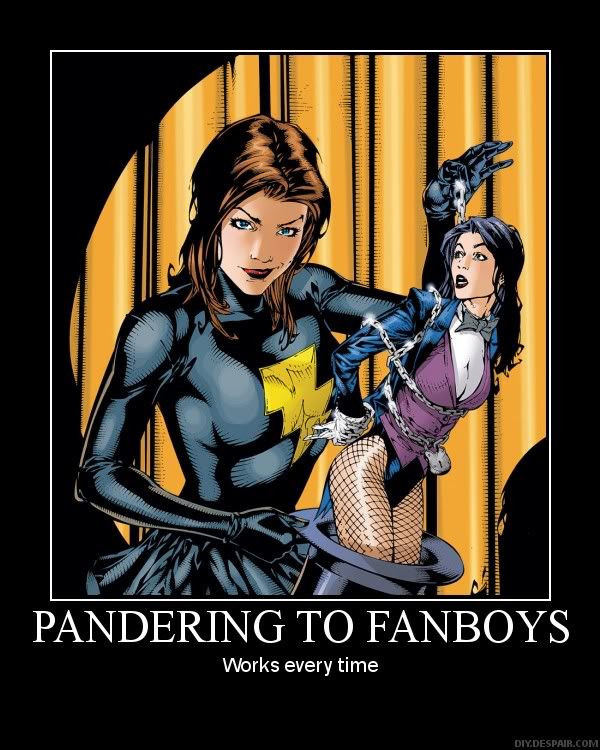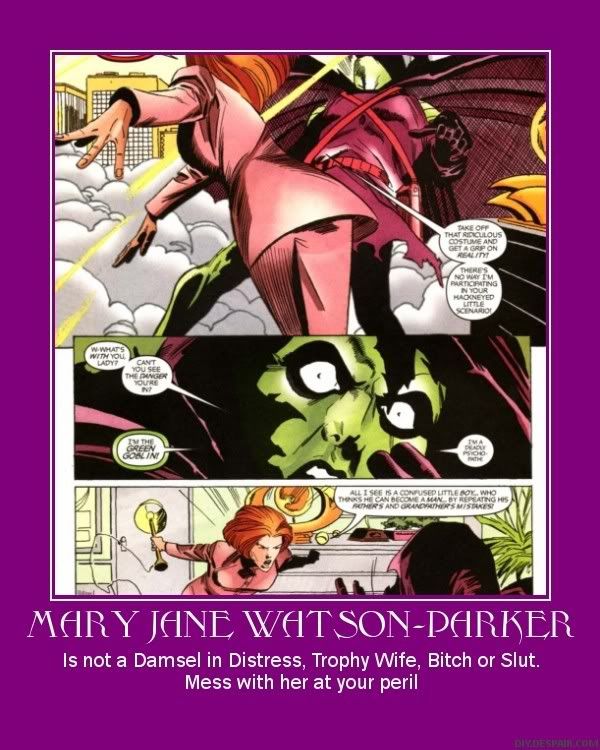 Hi, and welcome to the third in our series on comic book plot devices that need to go away
Hi, and welcome to the third in our series on comic book plot devices that need to go awayHere's #1
Here's #2
And tonight
Plot Devices that Need to Go Away #3:
DAMSELS IN DISTRESS
Also Known as: Rescue Meat, Girls in Refrigerators (when the hero doesn't get there in time), Lady or The Tiger, Captured Women, Dungeon Dramas
What is it?: The Love interest or some other woman of import to a hero is kidnapped by the villain in order to heighten tension and cause drama.
 Why do comic companies do it?: The primary reason here is because the story is traditional for these types of fantasy dramas. I mean, the original primary audience of superhero comics were the same as most other primitive genre fiction, in which a women was rescued by a hero/knight in shining armor or masked rogue type. At this point, it's metastasized into this gimmick in order to heighten the drama of a story because while most people realized that a superhero isn't in much danger, supporting characters are not as well protected.
Why do comic companies do it?: The primary reason here is because the story is traditional for these types of fantasy dramas. I mean, the original primary audience of superhero comics were the same as most other primitive genre fiction, in which a women was rescued by a hero/knight in shining armor or masked rogue type. At this point, it's metastasized into this gimmick in order to heighten the drama of a story because while most people realized that a superhero isn't in much danger, supporting characters are not as well protected.
Recent Offenders include but are not limited to: Mary Jane Watson (in all three Spider-Man Movies), Agent 13 (Captain America), Colleen Wing and Mysti Knight, Cowgirl (Green Lantern), Jessica Jones (New Avengers), Milla Donovan Murdock (Dardevil)
 Patient Zero: While we can go to Lois Lane as being the original Damsel in Distress for comic book women, she's largely been balanced in recent years (in most media) by being fairly independent, thoughtful, and resourceful enough to get herself out of a jam. So, the real cause of the modern over-reliance on this gimmick can be traced to exactly one source:
Patient Zero: While we can go to Lois Lane as being the original Damsel in Distress for comic book women, she's largely been balanced in recent years (in most media) by being fairly independent, thoughtful, and resourceful enough to get herself out of a jam. So, the real cause of the modern over-reliance on this gimmick can be traced to exactly one source:
GWEN STACY
And yes, I've read my fair share of Gwen 70's stories, and you know what? She's a Cipher. A nobody. She had the personality of a doorstop except when she was used as a foil for her friend, the far more interesting Mary Jane Watson. She's better known for how she died than what she did when alive, and the only reason anyone under the age of 30 remembers her is because she was the ultimate "damsel in distress" because SHE DIDN'T MAKE IT. Otherwise, she'd be as well known at Deb Whitman or whatever lame attempt they are throwing at Peter right now in the current Spider-Man story arc named for a bad Sting Song.
 Why does it have to go away?: Because the target demographic for most comics is not adolescent boys in need of a fantasy of rescuing a beautiful damsel (Some days, it seems that the target demographic is a bunch of men in a perpetual adolescence who need to be rescued by reality, but I try not to let such cynicism weight me down). Because we now live in an age where it is right and proper to show that women, super-powered or no, have the power, the cunning, and smarts to stand up for themselves and to serve as a better example. Because that should be one if not the primary goal of superhero fantasy; to provide a better example of how to live a just life.
Why does it have to go away?: Because the target demographic for most comics is not adolescent boys in need of a fantasy of rescuing a beautiful damsel (Some days, it seems that the target demographic is a bunch of men in a perpetual adolescence who need to be rescued by reality, but I try not to let such cynicism weight me down). Because we now live in an age where it is right and proper to show that women, super-powered or no, have the power, the cunning, and smarts to stand up for themselves and to serve as a better example. Because that should be one if not the primary goal of superhero fantasy; to provide a better example of how to live a just life.
Angles for Redemption of the Plot Device: I believe I will let Mary Jane speak for me on this one.
 Thanks MJ.
Thanks MJ.
2 comments:
That last one came straight from Spidergirl (a.k.a WHAT IF...Marvel allowed everyone in the Spidey books to grow up) I remember a long time ago during the Michelinie/McFarlane run when MJ was kidnapped, but wound up saving herself and wound up saving Spiderman in the process. The 'dansel in destress' is an outdated plot device that needs to have been done away with yesterday.
About Gwen Stacy: I find it strange that she started off as a wild, arrogant chick (especially when she was tussling with MJ to win over Pete), but the moment Pete chose her, she quickly and completely changed into the weeping girlfriend we are all familiar with.
Yeah...and the SINS PAST/REMEMBERED 'story'? IT NEVER HAPPENED. Neither did the Golbin's resurrection.
It's an overused plot device, but the reason that it persists is obvious. We the audience can not be counted on to care about random characters that were introduced a page before. So take an existing character that the readers have some kind of investment in and put them in peril to make sure the audience pays attention.
That said it can easily be overused (especially if it is the same character over and over again) or the peril drug out to long and the audience gets bored.
It works when used right which is a really rare thing.
Post a Comment